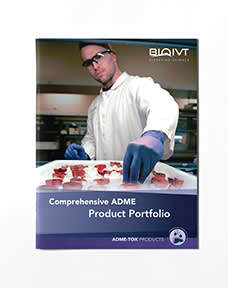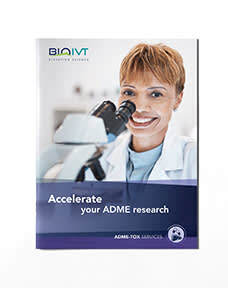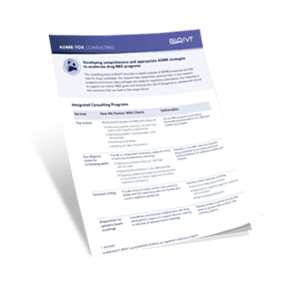Join Us in San Diego for a Complimentary Symposium on NAMs!
Regulatory agencies and industry innovators are accelerating the push to utilize scientifically validated New Approach Methodologies (NAMs), which aim to provide more human-relevant preclinical drug safety and efficacy data while eliminating unnecessary animal testing. In April 2025, the FDA unveiled the Roadmap to Reducing Animal Testing in Preclinical Safety Studies, mentioning potential incentives for regulatory review, and the NIH announced that they will no longer issue Notices of Funding Opportunities exclusively supporting animal models.
BioIVT will host a panel of industry experts at The Alexandria at Torrey Pines in San Diego for a series of presentations and discussions around the development, validation, and utilization of NAMs for a variety of ADME-Tox applications.
Registration is free but required to attend - save your seat today!
Symposium Agenda: Oct. 22, 2025


Baseline Characterization as a Key Foundation to Qualification of a Liver Microphysiological System
Presented by: Rhiannon Hardwick, PhD, BMS
The emergence of complex in vitro models (CIVM), including 3D multicellular tissues and microphysiological systems (MPS) such as tissue chips, offers new opportunities to better mimic human physiology and improve toxicity predictions in pharmaceutical research. However, integrating CIVM into testing pipelines presents challenges, such as the need for specialized expertise, evolving protocols, and sensitive biomarker detection. Careful characterization of baseline function, clear definition of context of use (COU), and rigorous qualification are essential for reliable toxicological assessment.
This presentation highlights the optimization of a liver MPS containing hepatocytes, Kupffer cells, liver sinusoidal endothelial cells, and stellate cells at physiological ratios in the CN Bio platform. Considerations for baseline characterization up to 22 days to ensure understanding of model homeostasis and donor cell strategy will be presented. Efforts to qualify the model for its ability to distinguish cholestatic drug-induced liver injury (cDILI) from mixed DILI will then be discussed. Using 10 positive and negative control compounds, the model demonstrated dose-dependent hepatic stress, reduced bile acid secretion, and downregulation of key transporters, consistent with known cDILI agents. These results underscore the importance of meticulous characterization and qualification to fully harness CIVM and MPS for improved toxicity prediction in pharmaceutical testing.

Elucidating Complex Drug-Drug Interaction Mechanisms of Chronic Rifampicin Exposure in Liver Tissue Chip
Presented by: Shiny Rajan, PhD, Javelin Biotech
Rifampicin is a complex drug that acts as a perpetrator for many co-administered drugs, causing clinically relevant drug-drug interactions (DDIs) via induction of cytochrome P450 (CYP) and UDP-glucuronosyltransferases (UGTs) with multiple dosing, and inhibition of hepatic organic anion transporting polypeptides (OATPs) with single dosing. While short-term DDIs are well characterized in primary human hepatocytes (PHHs), their rapid loss of function limits investigation of chronic mechanisms, including transporter regulation and bile acid alterations.
Here, we applied a human liver tissue chip (LTC) to evaluate rifampicin’s effects on enzyme and transporter expression, and bile acid profiles. First, LTC was validated with three individual donors retaining metabolic activity for up to four weeks and then their responses to short-term rifampicin induction were assessed across multiple dosing regimens by measuring CYP activity and mRNA changes. Based on the most relevant dosing protocol, chronic exposure of rifampicin’s effects on enzymes and transporters were then characterized by comparing mRNA and protein expression from the same chip.
Distinct differences between transcript and protein levels suggested post-transcriptional or post-translational regulation by rifampicin. Additionally, rifampicin exposure led to a time-dependent increase in glycine-conjugated bile acid species relative to DMSO controls, associated with decreased NTCP expression, increased MRP4 and OST-β, and enhanced basolateral efflux indicative of extrahepatic cholestasis. These findings highlight the LTC as a translational platform capable of modeling complex enzyme–transporter interactions and bile acid dynamics during chronic rifampicin exposure. The data will support physiologically based pharmacokinetic (PBPK) modeling to improve DDI predictions.


siRNA Knockdown in HEPATOPAC: A Novel Approach for Reaction Phenotyping of Low Turnover Drug Candidates
Presented by: Karissa Cottier, PhD, BioIVT
Accurately assessing drug-drug interactions and determining the specific contributions of cytochrome P450 (CYP) isoforms to drug metabolism and hepatic clearance can be particularly challenging when metabolic turnover is low. Traditional two-dimensional (2D) cell culture systems often fall short in this context, as they lack the long-term viability and sustained functionality required for comprehensive in vitro evaluation of metabolic pathways.
In this presentation, Dr. Cottier will discuss a novel approach to reaction phenotyping that uses siRNA-mediated gene knockdown to selectively inhibit enzyme activity in HEPATOPAC® co-culture systems. This method enables prolonged suppression of target CYP isoforms for over two weeks, providing a robust platform for studying metabolic pathways over extended periods. In these studies, siRNA knockdown was used for CYP3A4 and CYP2D6 to determine their respective abilities to accurately quantify the fraction metabolized (fm) for low-turnover compounds. Additionally, the impact of siRNA knockdown of all FDA recommended CYPS was assessed on both target and non-target enzymes by metabolic activity to determine their specificity and potential off-target effects.

From Bench to Roadmap: Human 3D Liver and Intestinal Models Driving Safer Drug Development
Presented by: Mehrsa Mehrabi, PhD, VivoSim Labs
The FDA’s Roadmap for reducing animal use highlights the urgent need for new approach methodologies (NAMs) that can better predict human toxicities and streamline drug development. At VivoSim Labs, we have developed 3D human liver and intestinal platforms using primary cells from both healthy donors and patients with MASH or IBD. These models replicate critical features of human physiology and disease biology, enabling more reliable detection of safety liabilities early in development.
Validation with marketed small molecules known to cause drug-induced liver injury (DILI) or gastrointestinal toxicity (e.g., diarrhea) has shown that these assays can reproduce clinically observed toxicities and generate actionable insights often missed by traditional 2D systems or animal models.
We now offer these advanced assays as a service to biopharma partners and actively pursue academic collaborations to broaden the range of use cases. Our platforms stand out for their model complexity, physiologic relevance, and translational value, providing industry and academic teams with a practical, regulatory-aligned solution to de-risk pipelines, reduce reliance on animals, and accelerate safer drug development.


From Barrier to Breakthrough: Validation and Implementation of Intestinal Organoid Monolayer for ADME
Presented by: Eugene Chen, PhD, Genentech
Traditional intestinal ADME models, including cell-free systems and immortalized cell lines such as Caco-2 and MDCK, inadequately represent human intestinal physiology due to species differences and lack of relevant transporters and metabolizing enzymes. Human intestinal organoids offer physiological relevance by recapitulating cellular diversity and functional characteristics essential for drug disposition studies.
This seminar presents a comprehensive evaluation of intestinal organoid monolayer technology for pharmaceutical ADME studies. Human intestinal organoid-derived epithelial cells were cultured in a monolayer configuration on permeable membrane supports using a 96-well format. We characterized barrier function, transporter activity, metabolic enzyme capacity, and nuclear receptor-mediated induction responses.
Intestinal organoid monolayers demonstrated robust barrier integrity with functional transporter activities for PEPT1, P-glycoprotein, and BCRP, and metabolizing enzyme activities for CYPs and UGTs. Importantly, apparent permeability determined in intestinal organoid monolayers correlated well with in vivo effective permeability and fraction absorbed for tested compounds. Case studies in PBPK modeling, FaFg prediction, and new modality studies further illustrate the versatility of the platform.
These results establish intestinal organoid monolayers as a promising platform for ADME applications. The technology offers enhanced predictive capabilities for assessing drug disposition and absorption, and has the potential to meet regulatory expectations for reduced animal testing. Implementation considerations and integration strategies for drug discovery workflows will be discussed.


Human on a chip systems to enable regulatory acceptance for efficacy and safety evaluation of therapeutics
Presented by: Larry Florin, CEO, Hesperos

Panel Discussion
Dr. Ogilvie will moderate a panel discussion with the symposium presenters.

The Alexandria Conference Center
The event will be held at The Alexandria, 10996 Torreyana Rd, San Diego, CA 92121. View parking instructions.
Resources

BioIVT has been the leading provider of ADME products for more than 25 years. In that time, we have isolated hepatocytes from several thousand human livers and continue to add several hundred new lots each year.

BioIVT provides ADME / DMPK services including consulting on ADME strategies, design and implementation of in vitro and in vivo studies, bioanalysis, analysis of study data, and report development.

Learn more about ADME Consulting Services at BioIVT. Our experts help researchers optimize in vitro research programs and ensure data packages are ready for regulatory submissions.